
Oxyria digyna is a species of flowering plant in the buckwheat family (Polygonaceae). It is native to arctic regions and mountainous parts of the Northern Hemisphere.
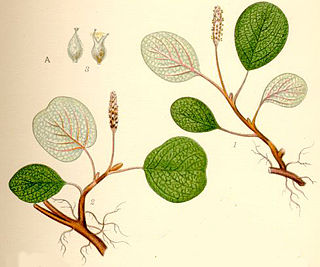
Salix reticulata, the net-leaved willow, or snow willow, is a dwarf willow, native to the colder parts of Europe, North America, and Northern Asia. It is found in the western United States, including the Sierra Nevada and Rocky Mountains. In Europe it extends south through the Carpathian Mountains and Alps to the Pyrenees and the mountains of Bulgaria and North Macedonia. It is common in Canada, Greenland and Finland, and present but rare in Scotland.
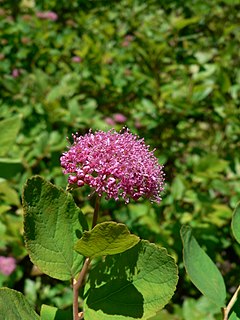
Spiraea splendens is a shrub of the rose family (Rosaceae) native to the western mountains of North America, from California to British Columbia, commonly known as dense-flowered spiraea, rose meadowsweet, rosy spiraea, subalpine spiraea, and mountain spiraea. It is commonly found at elevations between 2,000 and 11,000 feet on inland mountain ranges. The plant is adapted to cold, moist, rocky slopes, subalpine forests and meadows.

Darmera peltata, the Indian rhubarb or umbrella plant, is a flowering plant, the only species within the genus Darmera in the family Saxifragaceae. It is a slowly spreading rhizomatous perennial native to mountain streamsides in woodland in the western United States, growing to 2 m tall by 1 m wide. The name Darmera honours Karl Darmer, a 19th-century German horticulturist.
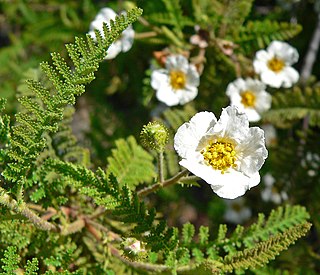
Chamaebatia, also known as mountain misery, is a genus of two species of aromatic evergreen shrubs endemic to California. Its English common name derives from early settlers' experience with the plant's dense tangle and sticky, strong-smelling resin. They are actinorhizal, non-legumes capable of nitrogen fixation through symbiosis with the actinobacterium, Frankia.
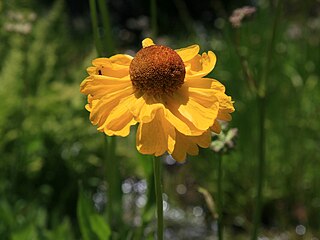
Helenium bigelovii is a North American perennial plant in the sunflower family, commonly known as Bigelow's sneezeweed. It grows in moist areas such as meadows, marshes, or streamsides. It is found at moderate and higher elevations (3000-10,000 ft) in the foothills and mountains of California and Oregon: Cascades, Coast Ranges, Klamath Mountains, Sierra Nevada, etc. Cultivars of the species are used in gardening as ornamentals.

Polemonium eximium, the skypilot or showy sky pilot, is a perennial plant in the phlox family (Polemoniaceae) that grows at high altitudes. It is endemic to the Sierra Nevada in California where it grows in the talus of the high mountain slopes.

Collomia grandiflora is a western North American annual plant in the phlox family (Polemoniaceae), known by the common names grand collomia, large-flowered mountain trumpet, and large-flowered collomia. It usually appears in sandy habitats and is cultivated as an ornamental.

Primula tetrandra, synonyms Dodecatheon tetrandrum and Dodecatheon alpinum, is a perennial plant in the primrose family, Primulaceae, known by the common name alpine shooting star.
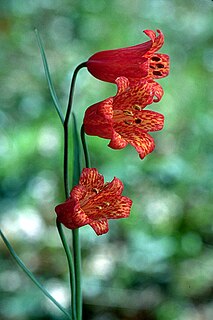
Fritillaria recurva, the scarlet fritillary, is a North American bulb-forming herbaceous perennial plant in the lily family Liliaceae. It is native to the western United States, from southwest Oregon down to northern California where it grows in the Klamath Mountains, Northern Coast Ranges, Cascade Range, and Sierra Nevada. Most of the known Californian locations are in the northern half of the state, as far south as Solano and El Dorado Counties, but there are isolated populations in Tulare and Mariposa Counties. The species has also been reported from Douglas and Washoe Counties in Nevada. It grows in dry, open woodlands and chaparral at 300–2,200 metres (980–7,220 ft), and it blooms in spring from February to July.
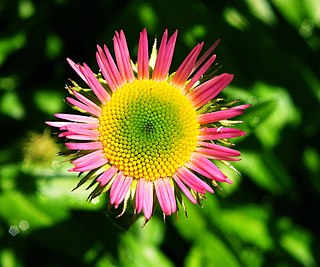
Oreostemma is a genus of flowering plants in the family Asteraceae. Species are found in western North America, with two endemic to California.
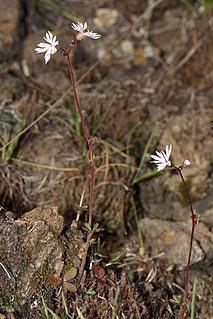
Lithophragma glabrum is a slender perennial western North American mountain plant in the Saxifrage family (Saxifragaceae), known by the common names bulbous woodland star, bulbiferous prairie-star, smooth woodland star, and smooth rockstar.

Rosa woodsii is a species of wild rose known by the common names Woods' rose, interior rose, common wild rose, mountain rose, pearhip rose, and prairie rose.

Streptanthus tortuosus is a biennial or short lived perennial plant in the mustard family (Brassicaceae) known by the common names shieldplant, shieldleaf, and mountain jewelflower.
Mixed coniferous forest is a vegetation type dominated by a mixture of broadleaf trees and conifers. It is generally located in mountains, below the upper montane vegetation type.
Salix petrophila, commonly known as alpine willow and Rocky Mountain willow, is a Northwest American mountain shrub in the willow family (Salicaceae).

Erigeron glacialis, the glacial daisy, glacial fleabane, Subalpine fleabane, or wandering fleabane, is a western North American perennial plant in the family Asteraceae.

Lupinus lepidus, the Pacific lupine, prairie lupine or dwarf lupine is a perennial herbaceous plant in the pea family (Fabaceae) endemic to western North America. Many varieties have been described, several of which are considered separate species by some authorities.

Cryptantha humilis is a perennial plant in the Borage Family (Boraginaceae). It is commonly called low cryptantha.
Cryptantha nubigena is a perennial plant in the Borage Family (Boraginaceae). It is commonly called Sierra cryptantha.

















